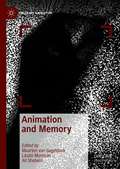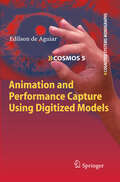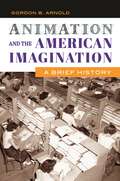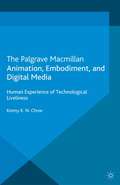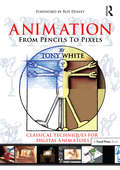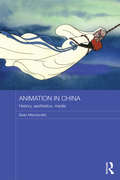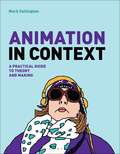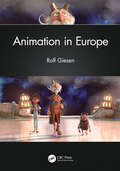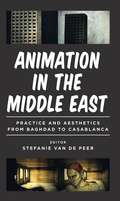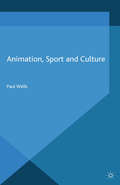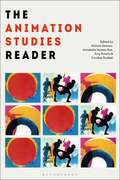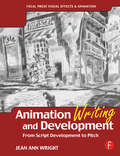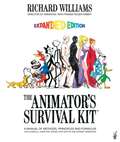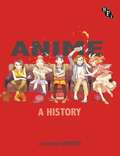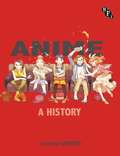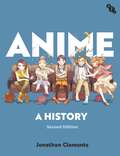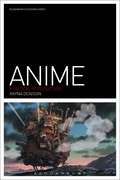- Table View
- List View
Animation and Memory (Palgrave Animation)
by László Munteán Maarten Van Gageldonk Ali ShobeiriThis book examines the role of memory in animation, as well as the ways in which the medium of animation can function as a technology of remembering and forgetting. By doing so, it establishes a platform for the cross-fertilization between the burgeoning fields of animation studies and memory studies. By analyzing a wide range of different animation types, from stop motion to computer animation, and from cell animated cartoons to painted animation, this book explores the ways in which animation can function as a representational medium. The five parts of the book discuss the interrelation of animation and memory through the lens of materiality, corporeality, animation techniques, the city, and animated documentaries. These discussions raise a number of questions: how do animation films bring forth personal and collective pasts? What is the role of found footage, objects, and sound in the material and affective dimensions of animation? How does animation serve political ends? The essays in this volume offer answers to these questions through a wide variety of case studies and contexts. The book will appeal to both a broad academic and a more general readership with an interest in animation studies, memory studies, cultural studies, comparative visual arts, and media studies.
Animation and Performance Capture Using Digitized Models (Cognitive Systems Monographs #5)
by Edilson de AguiarThe realistic generation of virtual doubles of real-world actors has been the focus of computer graphics research for many years. However, some problems still remain unsolved: it is still time-consuming to generate character animations using the traditional skeleton-based pipeline, passive performance capture of human actors wearing arbitrary everyday apparel is still challenging, and until now, there is only a limited amount of techniques for processing and modifying mesh animations, in contrast to the huge amount of skeleton-based techniques. In this thesis, we propose algorithmic solutions to each of these problems. First, two efficient mesh-based alternatives to simplify the overall character animation process are proposed. Although abandoning the concept of a kinematic skeleton, both techniques can be directly integrated in the traditional pipeline, generating animations with realistic body deformations. Thereafter, three passive performance capture methods are presented which employ a deformable model as underlying scene representation. The techniques are able to jointly reconstruct spatio-temporally coherent time-varying geometry, motion, and textural surface appearance of subjects wearing loose and everyday apparel. Moreover, the acquired high-quality reconstructions enable us to render realistic 3D Videos. At the end, two novel algorithms for processing mesh animations are described. The first one enables the fully-automatic conversion of a mesh animation into a skeletonbased animation and the second one automatically converts a mesh animation into an animation collage, a new artistic style for rendering animations. The methods described in the thesis can be regarded as solutions to specific problems or important building blocks for a larger application. As a whole, they form a powerful system to accurately capture, manipulate and realistically render realworld human performances, exceeding the capabilities of many related capture techniques. By this means, we are able to correctly capture the motion, the timevarying details and the texture information of a real human performing, and transform it into a fully-rigged character animation, that can be directly used by an animator, or use it to realistically display the actor from arbitrary viewpoints.
Animation and the American Imagination: A Brief History
by Gordon B. ArnoldProviding a detailed historical overview of animated film and television in the United States over more than a century, this book examines animation within the U.S. film and television industry as well as in the broader sociocultural context.From the early 1900s onwards, animated cartoons have always had a wide, enthusiastic audience. Not only did viewers delight in seeing drawn images come to life, tell fantastic stories, and depict impossible gags, but animation artists also relished working in a visual art form largely free from the constraints of the real world. This book takes a fresh look at the big picture of U.S. animation, both on and behind the screen. It reveals a range of fascinating animated cartoons and the colorful personalities, technological innovations, cultural influences and political agendas, and shifting audience expectations that shaped not only what appeared on screen but also how audiences reacted to thousands of productions. Animation and the American Imagination: A Brief History presents a concise, unified picture that brings together divergent strands of the story so readers can make sense of the flow of animation history in the United States. The book emphasizes the overall shape of animation history by identifying how key developments emerged from what came before and from the culture at large. It covers the major persons and studios of the various eras; identifies important social factors, including the Great Depression, World War II, the counterculture of the 1960s and 1970s, and the struggles for civil rights and women's rights; addresses the critical role of technological and aesthetic changes; and discusses major works of animation and the responses to them.
Animation and the American Imagination: A Brief History
by Gordon B. ArnoldProviding a detailed historical overview of animated film and television in the United States over more than a century, this book examines animation within the U.S. film and television industry as well as in the broader sociocultural context.From the early 1900s onwards, animated cartoons have always had a wide, enthusiastic audience. Not only did viewers delight in seeing drawn images come to life, tell fantastic stories, and depict impossible gags, but animation artists also relished working in a visual art form largely free from the constraints of the real world. This book takes a fresh look at the big picture of U.S. animation, both on and behind the screen. It reveals a range of fascinating animated cartoons and the colorful personalities, technological innovations, cultural influences and political agendas, and shifting audience expectations that shaped not only what appeared on screen but also how audiences reacted to thousands of productions. Animation and the American Imagination: A Brief History presents a concise, unified picture that brings together divergent strands of the story so readers can make sense of the flow of animation history in the United States. The book emphasizes the overall shape of animation history by identifying how key developments emerged from what came before and from the culture at large. It covers the major persons and studios of the various eras; identifies important social factors, including the Great Depression, World War II, the counterculture of the 1960s and 1970s, and the struggles for civil rights and women's rights; addresses the critical role of technological and aesthetic changes; and discusses major works of animation and the responses to them.
Animation, Embodiment, and Digital Media: Human Experience of Technological Liveliness
by K. ChowAnimation, Embodiment and Digital Media articulates the human experience of technology-mediated animated phenomena in terms of sensory perception, bodily action and imaginative interpretation, suggesting a new theoretical framework with analyses of exemplary user interfaces, video games and interactive artworks.
Animation from Pencils to Pixels: Classical Techniques for the Digital Animator
by Tony WhiteJust add talent!Award-winning animator Tony White brings you the ultimate book for digital animation. Here you will find the classic knowledge of many legendary techniques revealed, paired with information relevant to today's capable, state-of-the-art technologies.White leaves nothing out. What contemporary digital animators most need to know can be found between this book's covers - from conceptions to creation and through the many stages of the production pipeline to distribution. This book is intended to serve as your one-stop how-to animation guide. Whether you're new to animation or a very experienced digital animator, here you'll find fundamentals, key classical techniques, and professional advice that will strengthen your work and well-roundedness as an animator.Speaking from experience, White presents time-honored secrets of professional animaton with a warm, masterly, and knowledgeable approach that has evolved from over 30 years as an award-winning animator/director.The book's enclosed CD-Rom presents classic moments from animation's history through White's personal homage to traditional drawn animation, "Endangered Species." Using movie clips and still images from the film, White shares the 'making of' journal of the film, detailing each step, with scene-by-scene descriptions, technique by technique. Look for the repetitive stress disorder guide on the CD-Rom, called, "Mega-hurts." Watch the many movie clips for insights into the versatility that a traditional, pencil-drawn approach to animaton can offer.
Animation from Pencils to Pixels: Classical Techniques for the Digital Animator (Animation Foundation Bundle Ser.)
by Tony WhiteJust add talent!Award-winning animator Tony White brings you the ultimate book for digital animation. Here you will find the classic knowledge of many legendary techniques revealed, paired with information relevant to today's capable, state-of-the-art technologies.White leaves nothing out. What contemporary digital animators most need to know can be found between this book's covers - from conceptions to creation and through the many stages of the production pipeline to distribution. This book is intended to serve as your one-stop how-to animation guide. Whether you're new to animation or a very experienced digital animator, here you'll find fundamentals, key classical techniques, and professional advice that will strengthen your work and well-roundedness as an animator.Speaking from experience, White presents time-honored secrets of professional animaton with a warm, masterly, and knowledgeable approach that has evolved from over 30 years as an award-winning animator/director.The book's enclosed CD-Rom presents classic moments from animation's history through White's personal homage to traditional drawn animation, "Endangered Species." Using movie clips and still images from the film, White shares the 'making of' journal of the film, detailing each step, with scene-by-scene descriptions, technique by technique. Look for the repetitive stress disorder guide on the CD-Rom, called, "Mega-hurts." Watch the many movie clips for insights into the versatility that a traditional, pencil-drawn approach to animaton can offer.
Animation in China: History, Aesthetics, Media (Routledge Contemporary China Series)
by Sean MacdonaldBy the turn of the 21st century, animation production has grown to thousands of hours a year in the People’s Republic of China (PRC). Despite this, and unlike American blockbuster productions and the diverse genres of Japanese anime, much animation from the PRC remains relatively unknown. This book is an historical and theoretical study of animation in the PRC. Although the Wan Brothers produced the first feature length animated film in 1941, the industry as we know it today truly began in the 1950s at the Shanghai Animation Film Studio (SAFS), which remained the sole animation studio until the 1980s. Considering animation in China as a convergence of the institutions of education, fine arts, literature, popular culture, and film, the book takes comparative approaches that link SAFS animation to contemporary cultural production including American and Japanese animation, Pop Art, and mass media theory. Through readings of classic films such as Princess Iron Fan, Uproar in Heaven, Princess Peacock, and Nezha Conquers the Dragon King, this study represents a revisionist history of animation in the PRC as a form of "postmodernism with Chinese characteristics." As a theoretical exploration of animation in the People’s Republic of China, this book will appeal greatly to students and scholars of animation, film studies, Chinese studies, cultural studies, political and cultural theory.
Animation in China: History, Aesthetics, Media (Routledge Contemporary China Series)
by Sean MacdonaldBy the turn of the 21st century, animation production has grown to thousands of hours a year in the People’s Republic of China (PRC). Despite this, and unlike American blockbuster productions and the diverse genres of Japanese anime, much animation from the PRC remains relatively unknown. This book is an historical and theoretical study of animation in the PRC. Although the Wan Brothers produced the first feature length animated film in 1941, the industry as we know it today truly began in the 1950s at the Shanghai Animation Film Studio (SAFS), which remained the sole animation studio until the 1980s. Considering animation in China as a convergence of the institutions of education, fine arts, literature, popular culture, and film, the book takes comparative approaches that link SAFS animation to contemporary cultural production including American and Japanese animation, Pop Art, and mass media theory. Through readings of classic films such as Princess Iron Fan, Uproar in Heaven, Princess Peacock, and Nezha Conquers the Dragon King, this study represents a revisionist history of animation in the PRC as a form of "postmodernism with Chinese characteristics." As a theoretical exploration of animation in the People’s Republic of China, this book will appeal greatly to students and scholars of animation, film studies, Chinese studies, cultural studies, political and cultural theory.
Animation in Context: A Practical Guide to Theory and Making (Required Reading Range)
by Mark CollingtonAnimation in Context is an illustrated introduction to cultural theory, contextual research and critical analysis. By making academic language more accessible, it empowers animators with the confidence and enthusiasm to engage with theory as a fun, integral, and applied part of the creative process. Interviews with contemporary industry professionals and academics, student case studies and a range of practical research exercises, combine to encourage a more versatile approach to animation practice – from creating storyboards to set designs and soundtracks; as well as developing virals, 3D zoetropes and projection mapping visuals. Mark Collington focuses on a core selection of theoretical approaches that shape animation narrative, supported by a broader set of shared theoretical principles from the worlds of art, design, film and media studies. This discussion is underpinned by cross-disciplinary thinking on a range of topics including genre, humour, montage and propaganda. These are applied to the analysis of a range of animated films and projects from Disney and Animé, to independent artist-filmmakers such as Wendy Tilby, Amanda Forbis and Jerzy Kucia. These ideas are also applied to other uses of animation such as advertising, sitcom, gaming and animated documentary.
Animation in Europe
by Rolf GiesenThere is a lot one could say about animation in Europe, but above all, there is no consistent European animation. It is as disparate as the various countries involved. Audiences will certainly recognize American or Japanese animation, but in Europe, it can range from Czech, Polish, and Hungarian to Greek, Italian, Spanish, Portuguese, French, and British. Animation in Europe provides a comprehensive review of the history and current situation of animation in over 20 European countries. It features numerous interviews with artists and producers, including rare documents and firsthand accounts that illustrate the rich history of animation in Europe. Additional features include • An extensive chronology with key events in European animation • A Who’s Who of producers, directors, writers, and animators working in Europe • An examination of the origin of European animation and its influence Animation in Europe is the first book devoted entirely to this topic and, therefore, will be of value for animation buffs as well as practitioners and researchers.
Animation in Europe
by Rolf GiesenThere is a lot one could say about animation in Europe, but above all, there is no consistent European animation. It is as disparate as the various countries involved. Audiences will certainly recognize American or Japanese animation, but in Europe, it can range from Czech, Polish, and Hungarian to Greek, Italian, Spanish, Portuguese, French, and British. Animation in Europe provides a comprehensive review of the history and current situation of animation in over 20 European countries. It features numerous interviews with artists and producers, including rare documents and firsthand accounts that illustrate the rich history of animation in Europe. Additional features include • An extensive chronology with key events in European animation • A Who’s Who of producers, directors, writers, and animators working in Europe • An examination of the origin of European animation and its influence Animation in Europe is the first book devoted entirely to this topic and, therefore, will be of value for animation buffs as well as practitioners and researchers.
Animation in the Middle East: Practice and Aesthetics from Baghdad to Casablanca (20170230 Ser. #20170230)
by Stefanie Van PeerThe internationally acclaimed films Persepolis and Waltz with Bashir only hinted at the vibrant animation culture that exists within the Middle East and North Africa. In spite of censorship, oppression and war, animation studios have thrived in recent years - in Egypt, Iran, Iraq, Lebanon, Morocco, Palestine, Syria and Turkey - giving rise to a whole new generation of entrepreneurs and artists. The success of animation in the Middle East is in part a product of a changing cultural climate, which is increasingly calling for art that reflects politics. Equally, the professionalization and popularization of film festivals and the emergence of animation studios and private initiatives are the results of a growing consumer culture, in which family-friendly entertainment is big business. Animation in the Middle East uncovers the history and politics that have defined the practice and study of animation in the Middle East, and explores the innovative visions of contemporary animators in the region.
Animation in the Middle East: Practice and Aesthetics from Baghdad to Casablanca (World Cinema #20170230)
by Stefanie Van PeerThe internationally acclaimed films Persepolis and Waltz with Bashir only hinted at the vibrant animation culture that exists within the Middle East and North Africa. In spite of censorship, oppression and war, animation studios have thrived in recent years - in Egypt, Iran, Iraq, Lebanon, Morocco, Palestine, Syria and Turkey - giving rise to a whole new generation of entrepreneurs and artists. The success of animation in the Middle East is in part a product of a changing cultural climate, which is increasingly calling for art that reflects politics. Equally, the professionalization and popularization of film festivals and the emergence of animation studios and private initiatives are the results of a growing consumer culture, in which family-friendly entertainment is big business. Animation in the Middle East uncovers the history and politics that have defined the practice and study of animation in the Middle East, and explores the innovative visions of contemporary animators in the region.
Animation, Sport and Culture
by P. WellsAnimation, Sport and Culture is a wide-ranging study of both sport and animated films. From Goofy to Goalkeepers, Wallace and Gromit to Tiger Woods, Mickey Mouse to Messi, and Nike to Nationhood, this Olympic-sized analysis looks at the history, politics, aesthetics and technologies of sport and animation from around the globe.
The Animation Studies Reader
by Annabelle Honess Roe Amy Ratelle Nichola Dobson Caroline RuddellThe Animation Studies Reader brings together both key writings within animation studies and new material in emerging areas of the field. The collection provides readers with seminal texts that ground animation studies within the contexts of theory and aesthetics, form and genre, and issues of representation. The first section collates key readings on animation theory, on how we might conceptualise animation, and on some of the fundamental qualities of animation. New material is also introduced in this section specifically addressing questions raised by the nature, style and materiality of animation. The second section outlines some of the main forms that animation takes, which includes discussions of genre. Although this section cannot be exhaustive, the material chosen is particularly useful as it provides samples of analysis that can illuminate some of the issues the first section of the book raises. The third section focuses on issues of representation and how the medium of animation might have an impact on how bodies, gender, sexuality, race and ethnicity are represented. These representations can only be read through an understanding of the questions that the first two sections of the book raise; we can only decode these representations if we take into account form and genre, and theoretical conceptualisations such as visual pleasure, spectacle, the uncanny, realism etc.
The Animation Studies Reader
by Annabelle Honess Roe Amy Ratelle Nichola Dobson Caroline RuddellThe Animation Studies Reader brings together both key writings within animation studies and new material in emerging areas of the field. The collection provides readers with seminal texts that ground animation studies within the contexts of theory and aesthetics, form and genre, and issues of representation. The first section collates key readings on animation theory, on how we might conceptualise animation, and on some of the fundamental qualities of animation. New material is also introduced in this section specifically addressing questions raised by the nature, style and materiality of animation. The second section outlines some of the main forms that animation takes, which includes discussions of genre. Although this section cannot be exhaustive, the material chosen is particularly useful as it provides samples of analysis that can illuminate some of the issues the first section of the book raises. The third section focuses on issues of representation and how the medium of animation might have an impact on how bodies, gender, sexuality, race and ethnicity are represented. These representations can only be read through an understanding of the questions that the first two sections of the book raise; we can only decode these representations if we take into account form and genre, and theoretical conceptualisations such as visual pleasure, spectacle, the uncanny, realism etc.
Animation Writing and Development: From Script Development to Pitch
by Jean Ann WrightThe art. The craft. The business. Animation Writing and Development takes students and animation professionals alike through the process of creating original characters, developing a television series, feature, or multimedia project, and writing professional premises, outlines and scripts. It covers the process of developing presentation bibles and pitching original projects as well as ideas for episodes of shows already on the air. Animation Writing and Development includes chapters on animation history, on child development (writing for kids), and on storyboarding. It gives advice on marketing and finding work in the industry. It provides exercises for students as well as checklists for professionals polishing their craft. This is a guide to becoming a good writer as well as a successful one.
Animation Writing and Development: From Script Development to Pitch
by Jean Ann WrightThe art. The craft. The business. Animation Writing and Development takes students and animation professionals alike through the process of creating original characters, developing a television series, feature, or multimedia project, and writing professional premises, outlines and scripts. It covers the process of developing presentation bibles and pitching original projects as well as ideas for episodes of shows already on the air. Animation Writing and Development includes chapters on animation history, on child development (writing for kids), and on storyboarding. It gives advice on marketing and finding work in the industry. It provides exercises for students as well as checklists for professionals polishing their craft. This is a guide to becoming a good writer as well as a successful one.
The Animator's Survival Kit (PDF)
by Richard E. WilliamsAnimation is one of the hottest and most creative areas of film-making today . During his more than 40 years in the business, Richard Williams has been one of the true innovators, and serves as the link between the golden age of animation by hand and the new computer animation successes. In this book, based on his sold-out Animation Masterclass in the United States and across Europe, Williams provides the underlying principles of animation that very animator - from beginner to expert, classic animator to computer animation whiz - needs. Using hundreds of drawings, Williams distills the secrets of the masters into a working system in order to create a book that has become the standard work on all forms of animation for professionals, students and fans. This new expanded edition includes more on animal action, invention and realism with sophisticated animation examples
Anime: A History
by Jonathan ClementsThis comprehensive history of Japanese animation draws on Japanese primary sources and testimony from industry professionals to explore the production and reception of anime, from its early faltering steps, to the international successes of Spirited Away and Pokémon.
Anime: A History
by Jonathan ClementsThis comprehensive history of Japanese animation draws on Japanese primary sources and testimony from industry professionals to explore the production and reception of anime, from its origins in Japanese cartoons of the 1920s and 30s to the international successes of companies such as Studio Ghibli and Nintendo, films such as Spirited Away and video game characters such as Pokémon.
Anime: A History
by Jonathan ClementsJapanese animation is at the nexus of an international multimedia industry worth over $23.6 billion a year, linked to everything from manga to computer games, Pokémon and plushies. In this comprehensive guide, Jonathan Clements chronicles the production and reception history of the entire medium, from a handful of hobbyists in the 1910s to the Oscar-winning Spirited Away and beyond. Exploring the cultural and technological developments of the past century, Clements addresses how anime's history has been written by Japanese scholars, and covers previously neglected topics such as wartime instructional animation and work-for-hire for American clients. Founded on the testimonies of industry professionals, and drawing on a myriad of Japanese-language documents, memoirs and books, Anime: A History illuminates the anime business from the inside – investigating its innovators, its unsung heroes and its controversies. This new edition has been updated and revised throughout, with full colour illustrations and three new chapters on anime's fortunes among Chinese audiences and subcontractors, 21st century trends in 'otaku economics', and the huge transformations brought about by the rise of global streaming technology.
Anime: A History
by Jonathan ClementsJapanese animation is at the nexus of an international multimedia industry worth over $23.6 billion a year, linked to everything from manga to computer games, Pokémon and plushies. In this comprehensive guide, Jonathan Clements chronicles the production and reception history of the entire medium, from a handful of hobbyists in the 1910s to the Oscar-winning Spirited Away and beyond. Exploring the cultural and technological developments of the past century, Clements addresses how anime's history has been written by Japanese scholars, and covers previously neglected topics such as wartime instructional animation and work-for-hire for American clients. Founded on the testimonies of industry professionals, and drawing on a myriad of Japanese-language documents, memoirs and books, Anime: A History illuminates the anime business from the inside – investigating its innovators, its unsung heroes and its controversies. This new edition has been updated and revised throughout, with full colour illustrations and three new chapters on anime's fortunes among Chinese audiences and subcontractors, 21st century trends in 'otaku economics', and the huge transformations brought about by the rise of global streaming technology.
Anime: A Critical Introduction (Film Genres)
by Rayna DenisonAnime: A Critical Introduction maps the genres that have thrived within Japanese animation culture, and shows how a wide range of commentators have made sense of anime through discussions of its generic landscape. From the battling robots that define the mecha genre through to Studio Ghibli's dominant genre-brand of plucky shojo (young girl) characters, this book charts the rise of anime as a globally significant category of animation. It further thinks through the differences between anime's local and global genres: from the less-considered niches like nichijo-kei (everyday style anime) through to the global popularity of science fiction anime, this book tackles the tensions between the markets and audiences for anime texts. Anime is consequently understood in this book as a complex cultural phenomenon: not simply a "genre,†? but as an always shifting and changing set of texts. Its inherent changeability makes anime an ideal contender for global dissemination, as it can be easily re-edited, translated and then newly understood as it moves through the world's animation markets. As such, Anime: A Critical Introduction explores anime through a range of debates that have emerged around its key film texts, through discussions of animation and violence, through debates about the cyborg and through the differences between local and global understandings of anime products. Anime: A Critical Introduction uses these debates to frame a different kind of understanding of anime, one rooted in contexts, rather than just texts. In this way, Anime: A Critical Introduction works to create a space in which we can rethink the meanings of anime as it travels around the world.
